Friday, 20 July 2012
Distance 26 km
Duration 5 hours 30 minutes
Ascent 310 m, descent 433 m
Map 140 of the TOP100 lime-green series
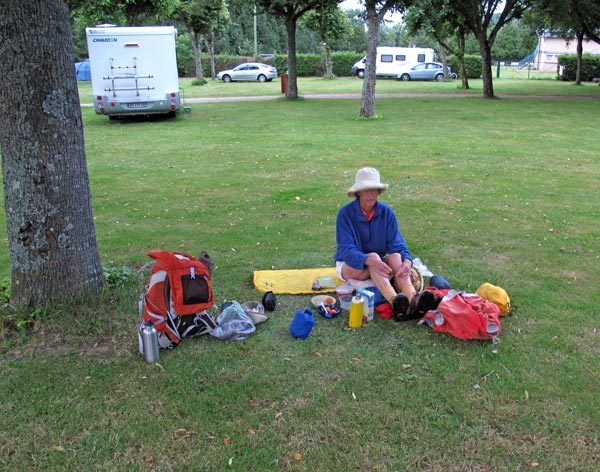
We were up early, but no earlier than our neighbours who had arrived late last night. The poorly dressed, grim-faced parents were sitting at a plastic table, brewing coffee on a spirit stove, and they did not look like holidaymakers. We got the feeling that all their worldly goods were in the trailer and that they had nowhere to go, so we left them to their private misery.
We ate our muesli with a few apricots scrounged from somewhere along the way yesterday, and set off before 7 am.
Because of Keith’s leg we had abandoned all ideas of going the slightly longer way via Évaux-les-Bains, so we went back towards the town, past the Intermarché, which was just opening, over the bridge and then turned right along the other bank of the river.
If we had been fully fit, we would have followed the GR46 as it scrambled up the rough hillside behind the abbey. It was not going in our direction for long, but could have kept us off the road for the first few kilometres. As it was, we decided to stick to the safety of the bitumen.
Keith was surprisingly speedy on the steep rise out of the valley. The road was densely forested until we reached the plateau, where it opened out into clear farmland and turned towards Budelière, a big village that promised the pleasure of second breakfast. As we passed the junction of the road from Évaux-les-Bains, we started to descend to the stream and Keith’s leg protested accordingly.
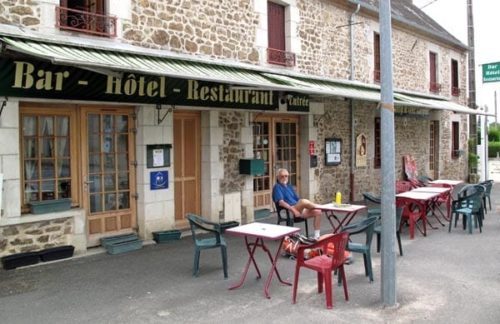
We saw Budelière long before we got to it, clumped tightly around the bald main road which shot uncompromisingly up the opposite slope. By the time we arrived Keith was in considerable agony, but we were cheered by the sight of a hotel about halfway up.
We dropped thankfully into chairs under the awning and it took us a while to realise that there were no other customers and that the doors were locked.
A notice on the wall announced that opening time was 10:30 am, more than two hours away. As this was the most likely village for a bar on the whole day’s march, we were greatly dispirited, but after a rest we trudged on up the hill.

Just past a boulangerie, at the edge of the houses, the only other shop was a little Vival supermarket with a sign listing all the extra services they provided. I cast a desultory eye down it – flowers, postage stamps, pressing, etc, then I saw “buvette/café”.
We hurried in and found a tiny counter with a coffee maker at the back of the shop. The woman said we could have coffee for €1, but she had no milk. We did not mind because we had powdered milk in my pack.
I dashed down to the boulangerie for pastries and a baguette, and when I got back, madame had produced a plastic table and chairs from somewhere, so we sat comfortably outside the doorway, surrounded by racks of fruit and postcards, with our refreshments.
It could have been just their unexpectedness, but the pastries seemed as good as any that we had ever eaten.
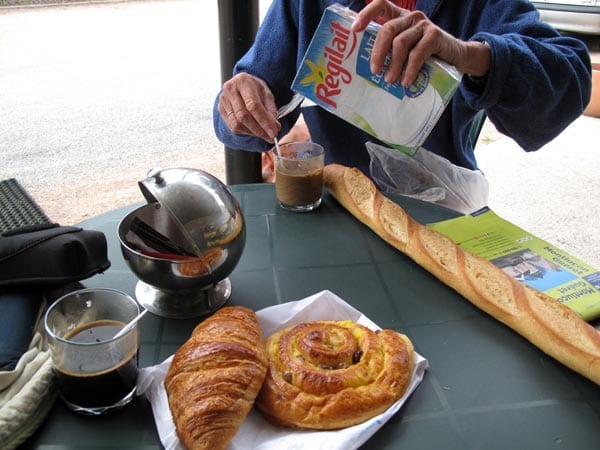
Revived and encouraged, we set off, over the rise and across another wide valley. Once again the downhill section was horrible for Keith, and consequently for me. I suffered vicariously as he laboured along, and I also worried about what damage he might be doing to his leg by carrying on.
When I suggested that we call the walk off in Montluçon, he replied that he was determined to get to the end and that he could cope with the pain. Simple soul that I am, I felt my mood swing instantly from anxious misery to relief and elation.
Past the few houses of Richeboeuf, the road rose again and we crossed the border into the department of the Allier, at the same time entering a new region – the Auvergne.
We continued for another hour or so, slowing down as we went, until we came to Argenty, where the first thing we saw was a defunct bar/restaurant.
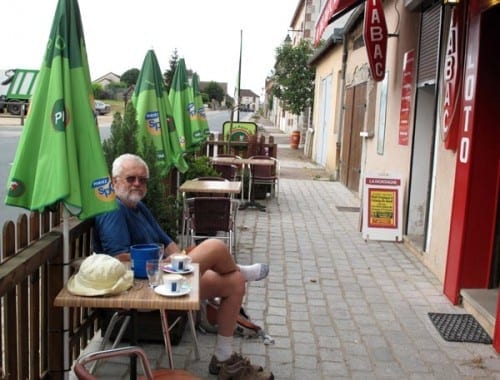
It was what we had expected from such a small place, so we pressed on doggedly through the village. Only when we were almost on top of it did we notice a little bar terrace with its leaf-green umbrellas nodding merrily.
For the second time that morning, disappointment was quickly followed by joy. The coffees were delicious and the simple act of sitting in a chair brought on feelings of ease and well-being.
We took off our shoes and Keith swallowed another couple of pills. There was a notice on the door announcing that the bar would be closed for a week, starting the following Monday, so we felt doubly lucky.
Then we had to face the final stage into Montluçon, which was about ten kilometres. The countryside was delightfully green and orderly, but all of it was slightly downhill, so Keith had trouble.
The hedgerows beside the road were full of ripe blackberries which relieved the boredom a little.
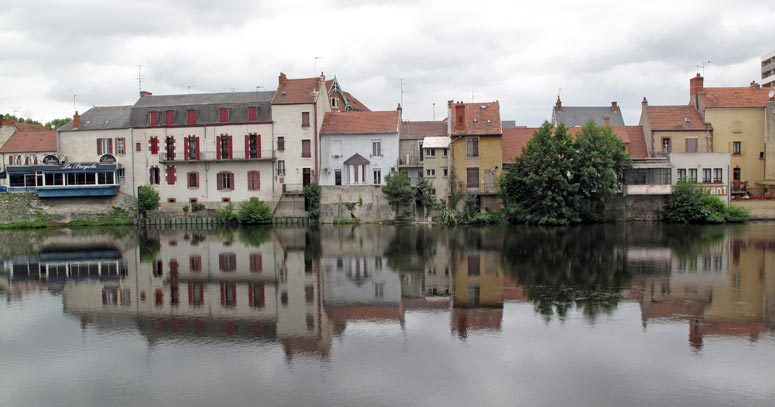
Further on we got to the built-up outskirts of the town, which were offensively ugly and seemed to go on for ever.
Eventually, at the bottom of a long slope, the road turned under the railway line and we suddenly found ourselves in the centre, on the edge of a beautiful lake formed by a barrage on the waters of the Cher, with graceful bridges and houses reflected in its silvery surface.
The sky was thick with clouds so we walked on in search of a hotel (there was no camping in Montluçon). By following signs for the Office of Tourism, we came to the main part of the old town, a busy circular avenue with the château (now a museum) at its centre, set on a low hill.
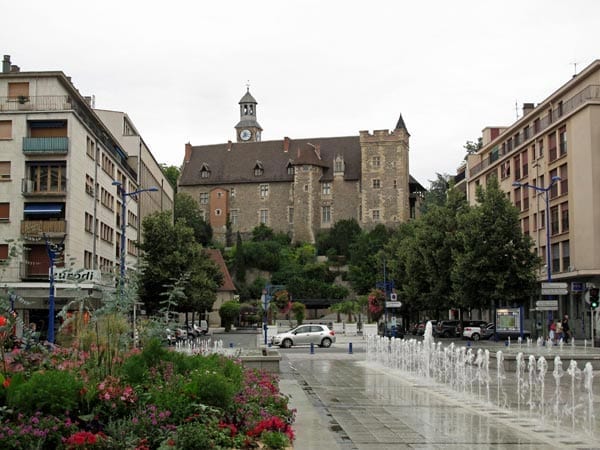
Before we got as far as the Office of Tourism we saw large side street with a pavement fountain and banks of flowers, where there was a sign pointing towards the railway station, and also four signs to hotels. This was good enough for us, especially for Keith in his broken-down condition.
As we expected, there was quite a little community around the station, with shops, hotels and restaurants. We chose the cheapest of the four hotels (€47) and settled in to our small, comfortable room on the first floor.
It was 1:30 pm so we had lunch first of all, arranging our bread, cheese and tomatoes on a bathmat laid over the bedspread. As it was raining outside by now, it was all the more enjoyable.
Then we had luxurious showers, but only washed our socks and undergarments, fearing that our walking clothes would not get dry by morning in the confines of the room. After dozing in front of the TV for a while (the Tour was on), we emerged into the street again and set off to find the Office of Tourism.
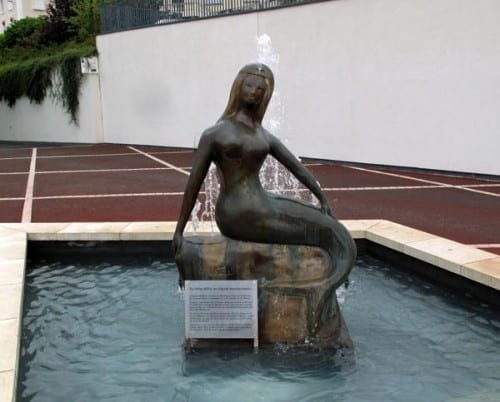
We found it further around the ring road and the man behind the desk was the soul of helpfulness. He produced a list of all the internet points and accommodation in Montluçon, together with a map on which he marked the beginning of the Canal de Berry, assuring us that it could be walked all the way, except for a few short detours.
With some difficulty we managed to get onto the internet in a sort of government office that had a computer for public use. It was a relief to deal with our emails after two weeks of enforced silence.
Outside in a paved corner, wet from another rain shower, we found a statue of the little mermaid of Montlucon, with the unfortunate name of Ikea. According to legend, after an earthquake had swallowed the great city of Atlantis, she had fled through the ocean, up the river Loire and had come to rest at this spot on the banks of the Cher.
Then we strolled about the steep little streets between the river and the château. The natural vantage point on which the château was built (in 1250) had been occupied previously by a fifth-century Gallo-Roman oppidum, the work of the pro-consul Lucius (hence the name of the town) and before that no doubt by prehistoric forts.

Presently our thoughts turned to eating, but the lanes close to the château, while picturesque, seemed to specialise in bars rather than restaurants.
There was one mock-mediaeval eatery that we were hustled into and even persuaded to sit down in. However we soon got up and walked out, rather rudely perhaps, but we had never been so pressured before in France.
We ended up back near the station, in a place called Scotts, which looked reassuringly well-patronised.
The interior was very fancy, with alarming pink-and-white decor, glass chairs and little booths around the walls. We occupied one of the booths, forsaking the glass chairs for soft, comfortable benches.
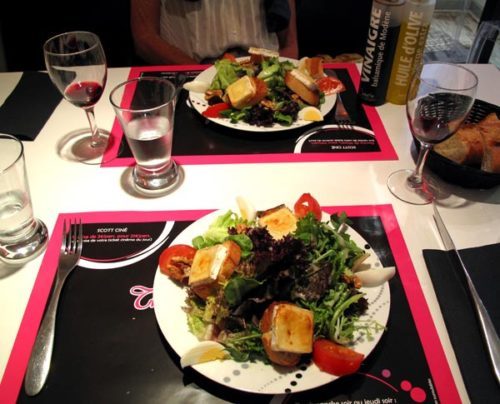
We decided on the menu rapide, three courses for €16.
First we had fine examples of the traditional salad of chèvre chaud, then the steaks known as bavettes, which came with a green pepper sauce.
We asked for green beans instead of chips to accompany this, and made up for the lack of substance by demolishing two baskets of bread. We also emptied two jugs of water and a carafe of wine.
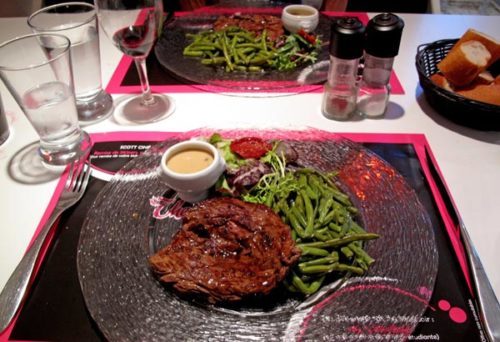
The grey-haired little manager, resplendent like all his staff in a monogrammed black T-shirt, seemed to take it as a personal compliment that we polished our plates so thoroughly, evidently not used to walkers’ appetites.
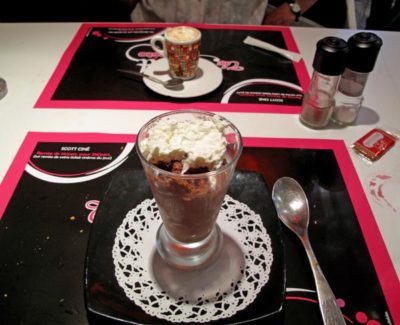
To finish, Keith had chocolate mousse made on the premises, and I had a coffee, to which I added some cream skimmed off Keith’s dessert. We only had to cross the road to be in our snug hotel room.
Previous day: Gouzon to Chambon-sur-Voueize